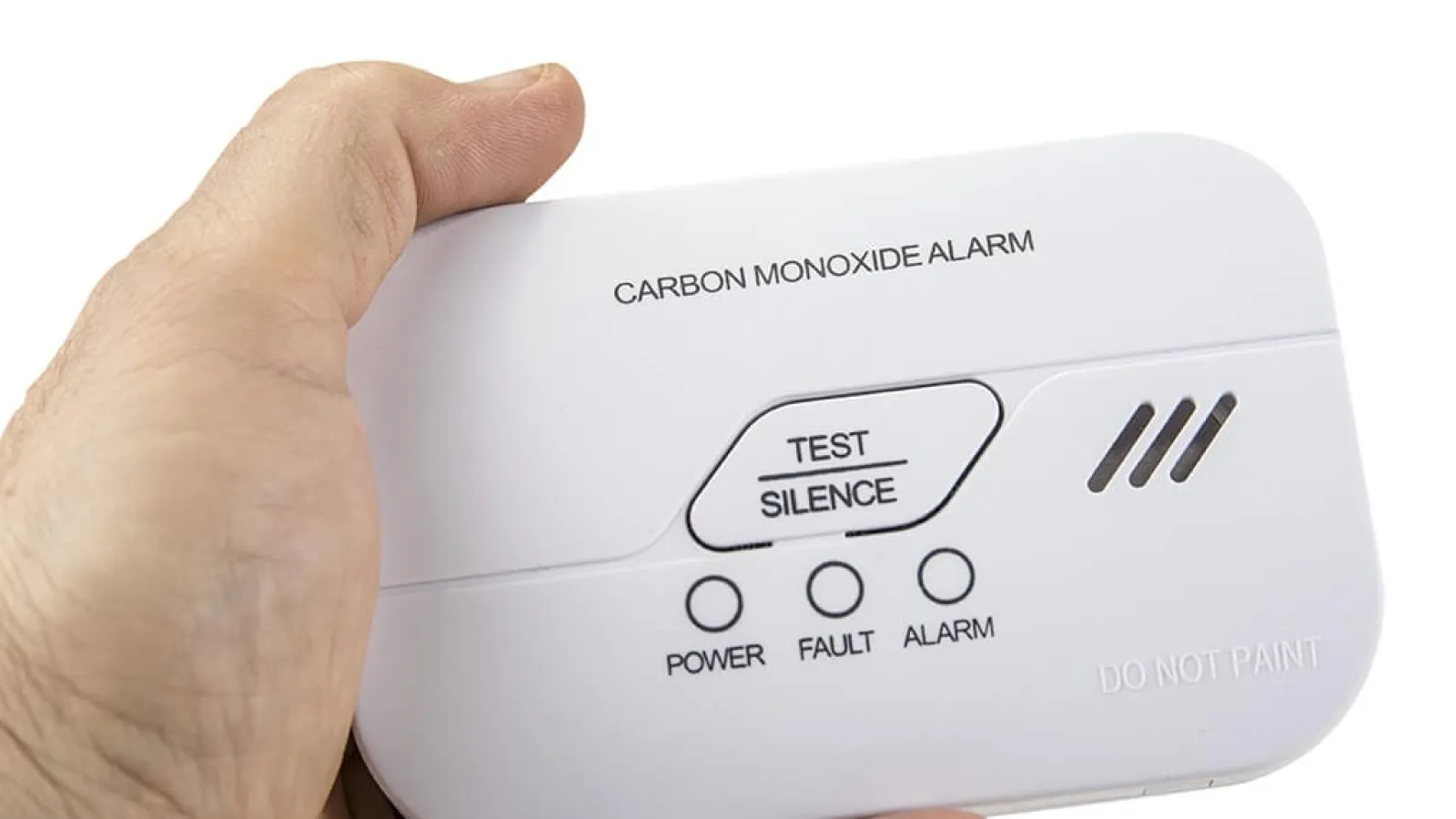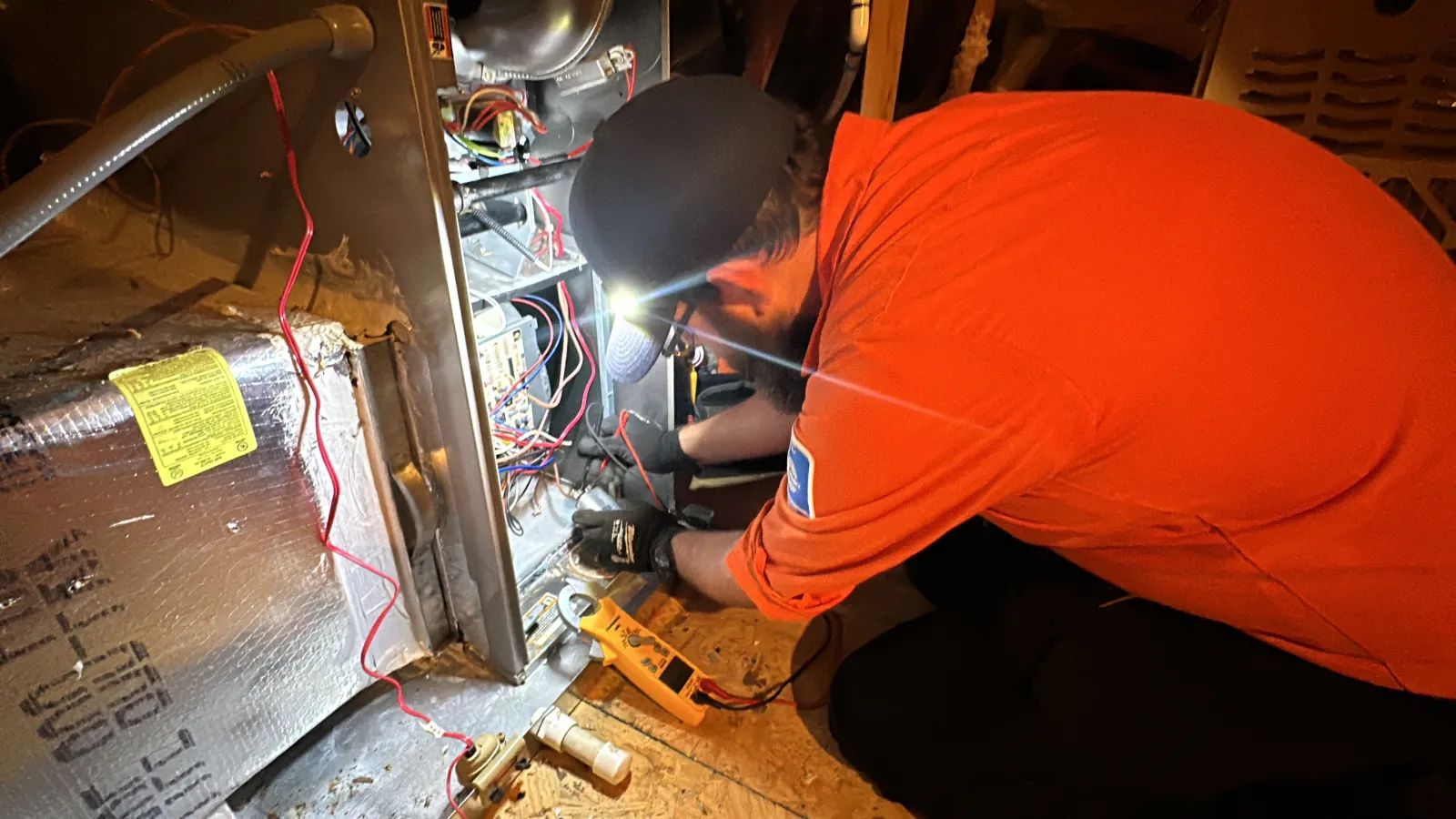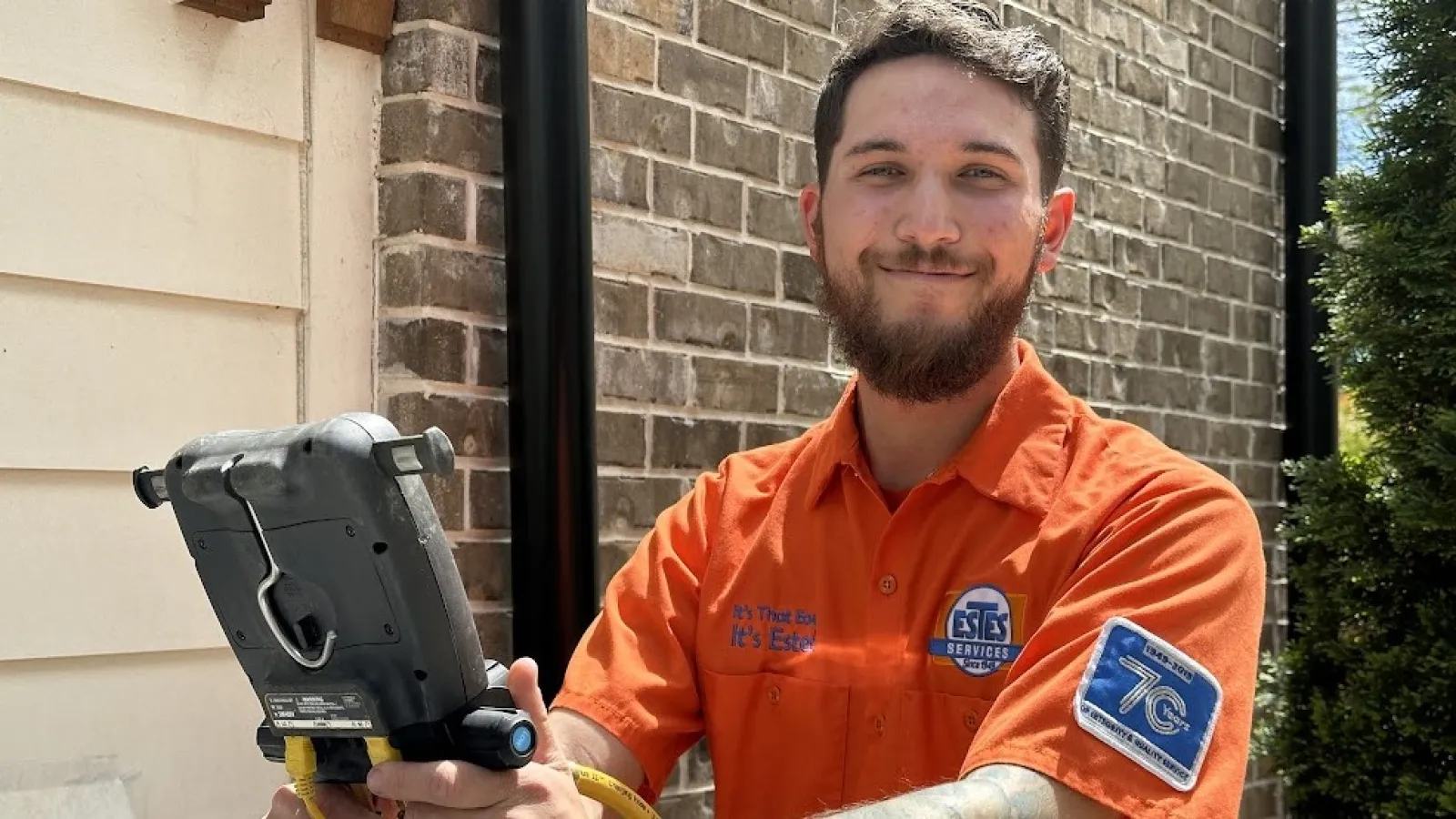In the midst of winter, it's important to be mindful regarding the potential for carbon monoxide exposure in the home. Atlanta area homeowners may have many carbon monoxide detector questions, which arise as you make home safety plans and install equipment to protect your family from the dangers of exposure.
Estes Services' team of heating professionals aim to keep our Atlanta area neighbors safe where their heating systems are concerned. We do so through comprehensive inspections and services that identify and correct potential sources of carbon monoxide leaks.
Additionally, we want to make sure you have answers to all important carbon monoxide detector questions. We've compiled this ultimate list of answers to frequently asked questions - find the answers you need to keep your family safe whenever gas appliances and heating systems are in use at home.
What Is Carbon Monoxide?
Carbon monoxide (CO) is a colorless, odorless and extremely toxic gas. Its presence in the home diminishes indoor air quality, and exposure leads to negative health consequences ranging in severity from mild to deadly. You can't see or smell it - exposure can kill before symptoms are ever present, which is why CO is sometimes referred to as the "silent killer."
It is a product of incomplete combustion. Carbon monoxide occurs when certain products are burned, such as gas, kerosene, wood, coal, oil, or propane.
How Many People Are Affected by CO Exposure Each Year?
More than 200 people in the U.S. are killed each year due to carbon monoxide originating from fuel-burning appliances. More CO-related fatalities occur due to exposure caused by burning charcoal within an enclosed space. Cars left running while within a home's attached garage cause additional CO deaths each year. In addition, CO poisoning is responsible for several thousand people seeking emergency room care each year.
Do I Need a Carbon Monoxide Detector?
If your Atlanta, GA home uses any fuel-burning appliances or has an attached garage or fireplace, you need a carbon monoxide detector. Carbon monoxide, or CO, is produced as a byproduct of combustion in fuel-burning appliances and in vehicles, as well as burning wood in a fireplace.
Where Should You Install a Carbon Monoxide Detector?
Install at least one carbon monoxide detector on every level of your home, as well as near sleeping areas. If you have only one carbon monoxide detector, the best location to install it is in the hallway outside of sleeping areas or in the main bedroom. Install CO detectors in locations where they will stay clean and not within the reach of children and pets.
Do not install a detector too close to fuel-burning appliances or to the attached garage. Installing a CO detector too close can give off false readings. Ensure it is installed a minimum of 15 feet away from your home's fuel-burning appliances and garage entrance.
You should not have a CO detector installed near windows, doors or in dead air spaces, as accurate readings may be affected in these areas.
Some companies manufacture combination smoke and CO detectors. If you own such a unit, you may have questions regarding correct installation spots. In this case, install them on the ceiling because smoke rises. Because CO gas does not rise, detectors specifically for CO may be installed lower. A common recommendation is knee-height, or where your head may be while sleeping.
Some units have digital displays. CO detectors that feature a digital display lets you verify the presence of CO at any time, so you are aware of levels and able to identify as well as correct causes before carbon monoxide volume rises to unsafe levels.
What Should I Do if My Detector Goes Off?
If your carbon monoxide detectors sound an alert, never ignore it! Have everyone exit the home to the fresh air outdoors. If it is not possible to exit the home, open windows and doors and stay nearby. Call 911 once the home has been evacuated.
Observe all occupants of the home for symptoms of carbon monoxide poisoning - if anyone experiences symptoms, seek immediate medical attention.
Have your local fire department inspect your home to identify the source of carbon monoxide. Have the issue corrected by a qualified technician immediately. Do not reenter the home until emergency personnel have cleared you to do so. If you have additional questions about carbon monoxide, seek answers from emergency responders.
What If No CO Was Found After the Alarm Went Off?
When a carbon monoxide alarm sounds, the unit has detected an unsafe level of the gas. However, emergency personnel may not be able to detect high CO levels when inspecting your home following the alert. This is due to:
- Dissipation of CO due to fresh air from open windows and doors, and the CO level has dropped since the carbon monoxide alarm sounded
- The alert was triggered by an issue that occurs on an occasional, not consistent, basis
Do I Need a Detector in My Motorhome?
Yes, CO detectors should be installed in motorhomes and other recreational vehicles. Per the Recreation Vehicle Industry Association, any towable recreational vehicle equipped with or prepped for a generator must have a CO detector installed.
How Long Do Carbon Monoxide Detectors Last?
CO alarms are not good forever and do require replacement after some time. The average CO detector needs to be replaced after 5 to 7 years of use. It may be necessary to replace units more frequently due to the environmental conditions within your home.
How Do I Test My Detector?
To test your carbon monoxide detector, hold down the TEST button on the unit until the alarm goes off - this can take many seconds, depending on the model. Only test the alarm using the unit's test button - do not intentionally expose the unit to a CO source in attempts to trigger the alarm, as this may cause damage to the unit, rendering it useless and potentially voiding equipment warranties.
How Do I Care for My Carbon Monoxide Detector?
Your CO detector requires regular maintenance for continued safe operation. Every week, use the detector test function - press the test button, which confirms proper operation.
Each month, carefully clean your CO alarm. Unplug the unit and gently clean away dust with a soft cloth or soft-bristle vacuum attachment.
Can My CO Detector Detect a Natural Gas Leak?
No, CO alarms do not detect leaks of natural gas or other explosive gas fuel. To detect these leaks, an explosive gas detector is needed. If your home uses natural gas or propane to power appliances, you should install one or more explosive gas detectors throughout the residence.
Where Does Carbon Monoxide Come From?
Exposure and subsequent CO poisoning results from many sources that may exist around your home, such as:
- Operating gas furnaces, clothes dryers, water heaters, ovens and fireplaces - any appliance that burns fuel has the potential to create carbon monoxide through normal operation
- Improper installation and malfunctions of any fuel-burning appliances
- Cracked or damaged heat exchangers in furnaces
- Vehicles, generators and combustion engines operating in enclosed spaces, such as an attached garage
- Blocked flue pipes and chimneys
- Air pressure changes in the home
- Back drafting
- Operating cooking grills or heaters in closed off areas
- Multiple fuel-burning appliances operating simultaneously within the home
At What Level Is CO a Danger to Your Health?
All people are different, which means CO exposure affects us all in different ways. The harm caused by CO exposure is dependent on the level of carbon monoxide as well as how long one is exposed and their individual health. CO concentration is expressed as parts per million (ppm), and mild health effects begin to be noticed at concentrations above 70 ppm. Serious health effects including disorientation, loss of consciousness, and death are possible when concentrations reach 150 to 200 ppm and above.
What Are the Symptoms of Carbon Monoxide Poisoning?
There are different levels of carbon monoxide exposure, each with different side effects on a person. It restricts the body's ability to move oxygen effectively. The different levels of exposure and their symptoms include:
Mild Exposure - fatigue, nausea and headaches
Moderate - sleepiness, disorientation, confusion, pounding headaches and accelerated heartbeat
Heavy - heart failure, convulsions, loss of consciousness, coma, brain damage and death
Signs That Could Indicate the Presence of the Gas?
There are a few visible signs that may indicate the presence of a problem, such as:
- Streaks of soot on the service door of your furnace
- No draft from your chimney
- Excessive rust found on flue pipes or appliance jackets
- Moisture from flue pipes, chimney base, or vents
- Exterior vent pipes have rust
How Can I Protect My Family from Poisoning?
Carbon monoxide poisoning is extremely dangerous, and it is critical you take measures to prevent it in your home. Here are some tips to protect your family:
- Install CO alarm on all levels of the home, outside sleeping areas, and in other appropriate locations throughout your living areas
- Test and replace the batteries in your CO alarm on a regular basis
- Ensure all appliances are installed up to local code standards and manufacturer instructions
- Have your heating system, flue, chimney, and vents checked by a professional at least once a year
- Have seasonal preventive maintenance performed on your furnace and all fuel-burning appliances in your home
- Make sure your HVAC unit is properly vented so combustion byproducts safely exit your home - examine chimneys and vents regularly to spot signs of damage, including improper connections, stains, and rust
- Don't let heating system problems linger - have a licensed technician perform necessary repairs as soon as an issue arises
- Keep your generator outside, at least 20 feet away from the home
- Vent fuel-burning space heaters during use
- Do not use gas ovens or cooktops for supplemental space heating
- When purchasing new appliances, only buy those approved by a nationally recognized testing lab
- Do not burn charcoal or fuel-burning camping gear within an enclosed space
- Do not leave your car running with the garage door opened or closed
- Never use fuel-burning engines, tools, or appliances in closed off areas that are attached to your home
- Do not use unvented fuel-burning appliances in rooms with closed doors or windows, or in rooms where people are sleeping
The best prevention is to install a carbon monoxide detector on each level of your home. Detection alerts your family in the event carbon monoxide becomes an issue in your home, allowing you and your loved ones to exit the home for safety. They also alert you to the presence of a carbon monoxide-producing issue, so you are able to investigate and make necessary repairs to eliminate the threat of continued exposure.
Estes Services Helps Safeguard Your Family from CO Exposure
At Estes Services, we work to ensure your home's heating equipment is in optimal condition not only for comfort and energy savings, but so it is safe for use and doesn't pose a risk to your family. We aim to ensure you have correct answers to your carbon monoxide questions, and the information you need to protect your family.
Our NATE-certified technicians perform thorough inspections of critical heating system components during seasonal tune ups to verify safe operation. These regular inspections allow us to detect any malfunctions posing a risk of carbon monoxide exposure and eliminate them at once through preventive repairs or replacement.
Our licensed electricians install carbon monoxide detectors in accurate and effective locations throughout the home. With this safety equipment in place, carbon monoxide is detected if present and your family members are immediately alerted to evacuate. By hardwiring carbon monoxide detectors, equipment is connected to the home's electrical system while utilizing the unit's batteries as a backup power source rather than the primary. This measure helps eliminate the danger dead batteries pose to your family.
Take steps to prevent carbon monoxide exposure in your Atlanta home while outfitting your living areas with the appropriate equipment for detection, just in case. Estes Services is here to help you improve the safety of your home - contact us today to learn more.



